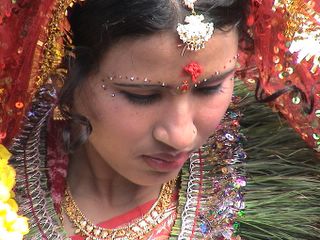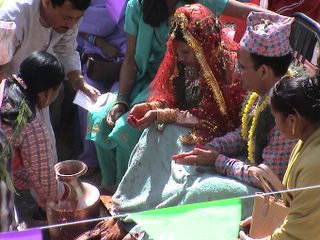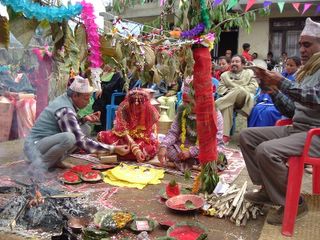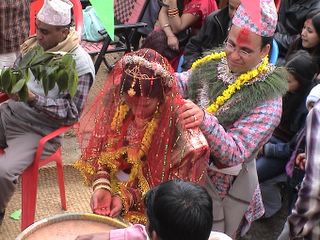Disaster Strikes: Nepal Hospital
I awoke the next morning in my apartment with a slight pain in my chest, but ignored it and got ready with my didi (who had spent the night) to go back to Bungamati and say goodbye to another didi's younger brother who had gotten his visa to go to America to study medicine. I felt worse and worse during the twenty minute bus ride, shaking with chills more and more - by the time we got to Bungamati, they had to bring me upstairs and put me in bed. I had a fever and a strange pain in my chest, and I felt delirious. I felt even worse that I was interrupting a very important time for a family to say goodbye to their son/brother/uncle and send him to the airport. Already an intern in a hospital, he took a look at me and worried I might have malaria. I wished him good luck in the US, and then my didi went to find a taxi to take me back to Kathmandu to the doctor's office.
The strange pains in my chest grew worse and worse, and the doctor sent me for a chest X-ray, which showed the beginnings of a pneumonia infection in my lung. He prescribed antibiotics and painkiller pills, and gave me a shot of morphine for the pain... You all who have ever seen me around needles know how bad the pain must have been for me to volunteer for a shot... I fainted as we waited for a taxi outside the doctor's office.
Back at my apartment, my didis put me to bed and I slept for a short while, they made me some soup, but I was sick on my bed and the floor... and in so much pain I could only roll back and forth. On top of this, the power went out, and I can only think how awful it must have been to try to take care of me that night, moving me to another bed (it didn't matter where I was, my whole body ached) and spoon-feeding me water and trying to make me take a pain pill whenever I woke up (which was often). The next morning we went straight back to the doctor's office in my landlord's car - I had been crying too loud for anyone not to notice and he volunteered to help.
The doctor checked the percentage of oxygen in my blood and found it very low, 84 I think, enough that he immediately called for an ambulance to take me to the hospital, gave me another shot of morphine which did very little, and a shot of strong antibiotics. My Nepali language teacher came to the doctor's office as well, she had called in the morning and knew what was going on. Dr. Johnny called the Fulbright director as well, who met us at the hospital. I can't quite explain how painful it was to breath - it was as though there was a knife planted inside my lung that my own body was slicing me down on every time I took a breath. The medical term for this is pleurisy, the inflammation of the pleural lining of the lung cavity. The ambulance ride was a blur, and the Nepal version of an emergency room was disturbing for me - many beds close together and a lot of other people in pain and seeing me in pain. The doctors didn't know what was wrong with me at first, took another X-Ray and an EKG of my heart (since I was complaining of chest pain). They gave me more morphine but as they gave it to them I told them it was no use, they had given me some before and it didn't make a difference. I wasn't feeling too positive, if you know what I mean. Didn't have too much patience for the doctors and nurses poking me and looking at me. Throughout the experience I had just begun, my pain took a higher priority to my personal commitment to cultural sensitivity - though, ironically, my experience in hospitals was perhaps one of my best lessons in Nepali culture.
Mike, the Fulbright director, arranged for me to have a private room in the hospital, and I waited for news of my X-Ray results. They kept giving me morphine and bright green antibiotics through an old-fashioned IV system. The toilet was across the hall and I demanded a toilet seat I could sit down on - no way to squat when it hurt to just move. I was just hoping and hoping that I would be better in time to go meet my dad at the airport, or at least to be able to show him some of Nepal. My didi phoned my other Nepali family and told them what was going on, and my aamaa came to see me as well. This was the first meeting of my Newar and Chhetri families, in the hospital. The doctors came after the Xray the next day, when I was feeling in somewhat less pain but still sick, to tell me that my lung cavity was filling with fluid and that they would need to take it out.
The big needle in the back thing was just about my worst nightmare. They had to suck out the fluid that was in my lung, and that was the easiest way... but they didn't give me enough local anesthetic, and I was crying from fear, so it was a horrible experience. My aamaa and my daai where there, and I was embarrassed that they had to see me crying. Everything about it was horrible.
There were two American doctors who had been doing rounds, and I complained to one of them about how painful that had been... so when the next XRay showed that the fluid was back, an American doctor, the head of the hospital, came to take the fluid out. This time he let me lay on my side, gave me anesthetic and a lot more morphine, and it wasn't so bad. I hoped and hoped and hoped that I would just get better in time for my dad, but I didn't improve and Mike went to pick up my dad at the airport. I got some help to wash my hair so I wouldn't look as awful when my dad saw me the first time for 7 months. I think I still looked pretty bad, but it was reallllllly nice to have him be there, and to be able to have my Nepalese families take a break from taking care of me. (At least one person had to be with me at all times, because the nursing profession in Nepal doesn't involve bathroom assistance, and they just don't have anyone to bring you food or give you something if you need it).
My dad's first experience in Nepal must have been pretty horrendous, his daughter in the hospital and all he saw were the crazy roads and lots of people all over. Even though my spirits were down, I still wanted him to meet my Nepali family and be able to translate everything for them. After my dad arrived, though, the doctor came to tell us that the second try at removing the fluid had failed again, and that they would have to use a chest tube. This was an even worse idea than the big needle. A tube is like the biggest possible needle imaginable, only bendy.
WARNING: THOSE WHO DON'T LIKE GORE, SKIP TO NEXT PARAGRAPH
A chest tube insertion is not considered an operation, and can be done in the hospital room. However, it is a difficult procedure because the doctor has to force the tube into the chest cavity, and there is some pretty tough tissue surrounding the ribs and lungs. I lay on my side and my dad held my hand, and I was pretty much scared out of my wits, and the doctor put one knee up on the bed so he could get enough leverage to poke the tube through. It was a horrible horrible feeling and I yelled. The pressure from the fluid trapped in my lung forced its way up and sprayed everywhere - it was a good thing my dad was wearing glasses. The doctor clamped the tube so they could control when they let the fluid out. I wasn't getting enough oxygen ever so I had to have the little oxygen thingy that sticks up your nose, which makes you look really sick and in the hospital. They came back to let out more fluid late that night, and it was one of the worst pain moments, as the tube had messed with a nerve and caused a pain to shoot right up into the inside of my shoulder joint. They opened that tube clamp and it was like on Princess Bride when they have Wesley strapped to the torture machine. I was given morphine (I was being given morphine intermittently throughout the entire time really, it became like a little friend) but I was delirious and going in and out of consciousness, especially when they had to come and take an Xray, lifting me up to slide the panel behind me...
Meanwhile, there were people coming to visit me continously. It was like a party in some ways actually, and a party in my honor really. It wasn't good in the sense that I didn' t get to rest as much as I should, and had to use energy to speak Nepali and explain things. But it was good in the sense that I felt very cared for, and I liked that my dad got to at least meet my family. The tube drainings were so bad, and my oxygen level so low, that the doctor put me in the Intensive Care Unit. I HATED THE ICU. The nurses there are used to dealing with unconscious people, I think, so they right off the bat threatened to use a catheter, for going to the bathroom... For those who think I'm a pushover (ok ok, you're right, I am) I was extremely outgoing in asserting my opinion that time, no catheter for me! They also instisted on giving me the antibiotics undiluted - the nurses in my ward had gotten so tired of me whining and crying that they mixed the antibiotics with saline before putting it into an IV drip. That green stuff going into my arm felt like a bunch of fire ants on parade. I hated it. And I hated the IV, which had to be moved around every couple of days because it would hurt too much, and I was running out of easy veins. The ICU nurses would wake me up in the middle of the night just to take my temperature. There were alarms continuously going off and keeping me from sleeping. My dad couldn't stay with me all the time, as there wasn't room for a second cot. Kamal called from the US and I couldn't talk to him because there was no phone. Finally after much pleading the doctor allowed me to go back to my regular room.
The Xrays improved so they took the tube out and allowed me to leave the hospital. I developed a weird burping problem, where I would have burping attacks. Mike invited my dad and I to come stay at his house for a while, and since I was worried about my dad having to go out to get food etc to bring back to my apt, I said yes. It was nice to stay there but I still felt sick and my dad really wanted to rest. The followup Xray showed that the fluid had come back, as much as ever before, and that I would need another tube. I was so disappointed when I heard this, I didn't know what to do. My dad and I went to ask for advice from my first doctor, who thought my idea of going to Thailand would work out ok. He was going to Thailand in two days anyways, and said it would be easy for me and my dad to come at the same time, so he could escort me to the emergency room there. I had to have a second tube inserted before I left, but they put me under with some twilight anesthetic this time, after they finally found a vein to use (it took them ten minutes). This meant I was awake but don't remember the procedure. The doctor said I complained about the pain and then mumbled for the rest of the time. Sounds about right.
I cried when I had to say goodbye to my families as we left the hospital. I was happy to go to Thailand but very sad to not have them with me anymore. I had my dad though so I was doing fine.
















